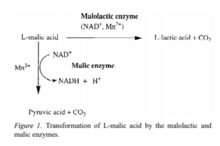User:RavynCasey/Lactic acid bacteria
 | This is a user sandbox of RavynCasey. You can use it for testing or practicing edits. This is not the sandbox where you should draft your assigned article for a dashboard.wikiedu.org course. To find the right sandbox for your assignment, visit your Dashboard course page and follow the Sandbox Draft link for your assigned article in the My Articles section. |
Exopolysaccharides[edit]
The quest to find food ingredients with valuable bioactive properties has encouraged interest in exopolysaccharides from LAB. Functional food products that offer health and sensory benefits beyond their nutritional composition are becoming progressively more important to the food industry. The sensory benefits of exopolysaccharides are well established, and there is evidence for the health properties that are attributable to exopolysaccharides from LAB. However, there is a wide variation in molecular structures of exopolysaccharides and the complexity of the mechanisms by which physical changes in foods and bioactive effects are elicited.[1]
Lactic Acid Bacteria and Dental Plaque[edit]
LAB are able to synthesize levans from sucrose, and dextrans from glucose.[2] Glucans, such as dextran, enable bacteria to adhere to the surface of teeth, which in turn can cause tooth decay through the formation of dental plaque and production of lactic acid.[3] While the primary bacteria responsible for tooth decay is Streptococcus mutans, LAB are among the most common oral bacteria which cause dental cavities.[4]
Lactic acid Bacteria and fermentation of beverages[edit]

Lactic acid bacteria are used in the food industry for a variety of reasons such as the production of cheese and yogurt products. This process has been going on for thousands of years by human ancestors. But, some of the beverages we enjoy today are produced by using lactic acid bacteria. Popular drinks such as kombucha have known to have traces of lactobacillus and pediococcus once the drink is made.[5] Even the beer and wine-making process utilizes certain lactic acid bacteria mostly lactobacillus. The interesting relationship between lactic acid bacteria and yeast can be observed in the wine-making process. The LAB is used to start the wine-making process by starting the malolactic fermentation. After the malolactic fermentation, yeast cells are used to start the alcoholic fermentation process in grapes. The malolactic fermentation mechanism is mainly transformation of L-malic acid (dicarboxylic acid) to an lactic acid (monocarboxylic acid).[6] This change occurs due to the presence of malolactic and malic enzymes. All malic acid are degraded and this increase the pH levels which changes the taste of the wine.[6] Not only do they start the process but they are responsible for the different aromas produced in wine by the nutrients presence and the quality of the grapes. Also, the presence of different strains can change the desirability of aromas' presence. The different availability of enzymes that contribute to the vast spectrum of aromas in wine are associated with glycosidases, β-glucosidases, esterases, phenolic acid decarboxylases and citrate lyases.[7] By using molecular biology, researchers can help pick out different desirable strains that help improve the quality of wine and help with the removable of the undesirable strains. The same can be said about brewing beer as well which uses yeast with some breweries using lactic acid bacteria to change the taste of their beer.[8]
Lactic Acid Bacteria strains and their susceptibility to Antibiotics[edit]
There is variety of antibiotics which are currently being used in medicine and their role is to inhibit the spread of infections in the human body.[9] Lactic acid bacteria have many different strains such as Lactobacillus acidophilus, Lactobacillus helveticus, Lactobacillus delbrueckii subsp. bulgaricus, Enterococcus and many of them are resistant to antibiotics, however there are some strains which are quite susceptible to certain antibiotics. These antibiotics are penicillins, cefoxitin and vancomycin and their function is cell-wall synthesis inhibition.
- ^ Welman AD (2009). "Exploitation of Exopolysaccharides from lactic acid bacteria". Bacterial Polysaccharides: Current Innovations and Future Trends. Caister Academic Press. ISBN 978-1-904455-45-5.
- ^ White, David; Drummond, James; Fuqua, Clay. The Physiology and Biochemistry of Prokaryotes (Fourth ed.). pp. 331–332. ISBN 978-0-19-539304-0.
- ^ Brock biology of microorganisms (11th ed.). Pearson Prentice Hall. ISBN 978-0-13-144329-7.
- ^ Tanzer, JM; Livingston, J; Thompson, AM (October 2001). "The microbiology of primary dental caries in humans". Journal of dental education. 65 (10): 1028–37. PMID 11699974.
- ^ Nguyen, Nguyen Khoi; Dong, Ngan Thi Ngoc; Nguyen, Huong Thuy; Le, Phu Hong (2015-02-24). "Lactic acid bacteria: promising supplements for enhancing the biological activities of kombucha". SpringerPlus. 4. doi:10.1186/s40064-015-0872-3. ISSN 2193-1801. PMC 4348356. PMID 25763303.
{{cite journal}}: CS1 maint: unflagged free DOI (link) - ^ a b Lonvaud-Funel, A. (1999-07). "Lactic acid bacteria in the quality improvement and depreciation of wine". Antonie Van Leeuwenhoek. 76 (1–4): 317–331. ISSN 0003-6072. PMID 10532386.
{{cite journal}}: Check date values in:|date=(help) - ^ Cappello, Maria Stella, et al. “Linking Wine Lactic Acid Bacteria Diversity with Wine Aroma and Flavour.” Science Direct , https://www-sciencedirect-com.hal.weber.edu/science/article/pii/S0168160516306468.
- ^ Dysvik, Anna; Liland, Kristian Hovde; Myhrer, Kristine S.; Westereng, Bjørge; Rukke, Elling-Olav; de Rouck, Gert; Wicklund, Trude (2019). "Pre-fermentation with lactic acid bacteria in sour beer production: Pre-fermentation with lactic acid bacteria in sour beer production". Journal of the Institute of Brewing. 125 (3): 342–356. doi:10.1002/jib.569.
- ^ "Safety and efficacy of Probiotic LACTINA® (Lactobacillus acidophilus, Lactobacillus helveticus, Lactobacillus bulgaricus, Lactobacillus lactis, Streptococcus thermophilus, Enterococcus faecium) for chickens for fattening, piglets and pigs - Scientific Opi". EFSA Journal. 7 (1): 912. 2009-01. doi:10.2903/j.efsa.2009.912. ISSN 1831-4732.
{{cite journal}}: Check date values in:|date=(help)
